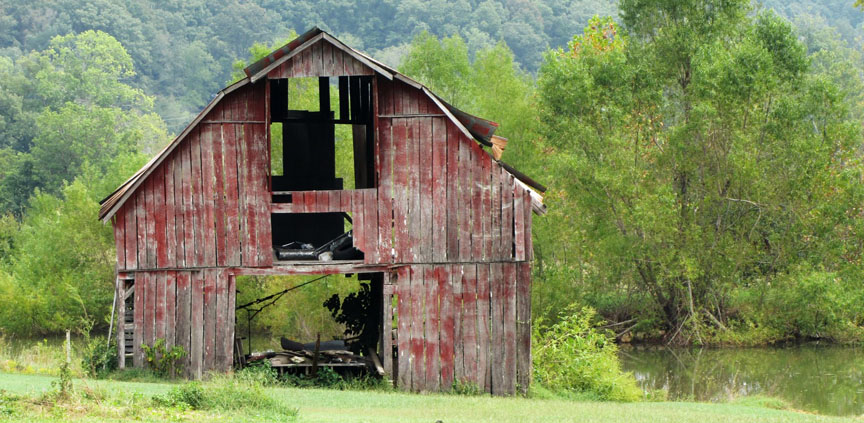WOOD SPECIES: The hardwoods Oak, Chestnut, Hickory, Beech, Elm, and the softwoods Hemlock, White Pine and Spruce.
COMMON SIZES: 2-3” x 8-12” x 15’+ lumber up to 12 x 14” timbers.
DEFINING CHARACTERISTICS: Weathered face, Hand-hewn, circular and band sawn textures. Faded paint and greyish brown colors. Bolt holes and irregular construction cuts.
GEOGRAPHY: Barns are common in many parts of the country, but our woods are sourced in the East, primarily from Ohio, Pennsylvania and parts of New York and New England. Traveling further south one begins to see more red oak than white oak and further north into Canada and northern New England one finds more softwoods, as well as beech and maple. Although one occasionally finds oak in industrial structures, the majority of reclaimed white oak and most other hardwoods for that matter, come from barns.
CONSTRUCTION
As building type, Barns have been such an important part of America and agricultural history. Early on, they were essentially just architecture for animals, with one side for cattle and the other for horses. Eventually pigs, sheep, and goats moved in. Most barns were traditional timber frame, though the beams were often sawed in later years rather than hewn with an ax. Then barns were covered with vertical board siding. The construction was sturdy and large doors rolled on factory-made tracks. The later barns had more ornaments added, such as cupolas and mill work designs, and when freshly painted, were a striking sight, and endlessly photographed. Learn more
Barns take a real beating and the time tested construction is basically a framework of solid timbers with exterior barn siding which can be removed and replaced over time. The frames are often beautifully proportioned with simple lines that give the designs a charm and integrity that seems lost in much of todays pre-fab pole and metal constructions.
In the old days, it was traditional to have a barn raising party, with relatives and friends helping to build a barn, often in a few days. The Amish still do it today.
STYLES
“Here, in this small and magic box,
The farmer crowds his fields and flocks;
Arithmetic can never tell
How one barn holds the farm so well.”
– Ralph Seager, Penn Yan, NY poet
Barns come in all sizes and shapes, as the various styles serve different functions. The first great barns built in this country were those of the Dutch settlers of the Hudson and Mohawk valleys in New York State. Relatively few Dutch barns survive in good condition or unaltered.
Some of the more common designs over time include Bank Barns, that were built into the side of a hill. Crib barns, popular in the South, and including multiple cribs or pens for cattle or pigs, with a hayloft above. Round Barns (George Washington owned one) in the Midwest, which had a greater volume-to-surface ratio than the rectangular, and required fewer materials. And the iconic Prairie Barn, with it’s peak roof above a hayloft, which was usually much larger than the other barns.
Barns can sometimes reflect ethnic traditions and local customs; along with changing farming practices, building techniques and technology. The Finnish log barns in Idaho, Czech and German-Russian barns in the Dakotas, and English barns in the northeast. Some are characterized by their use – dairy, tobacco, hop-drying, rice, etc. Others were just sold by Sears, Roebuck and Company or other mail-order firms. And some don’t fit into any category, but all are part of the country’s heritage.
And why are nine out of ten barns painted Red? One explanation is because most barns are very large, and red was the cheapest paint available. But the color sure matches the charm and romance that barns reflect.
FUNCTION AND DEVELOPMENTS
In the nineteenth century came a new era of farm construction, which accelerated after the Civil War, and brought on changes in barns with complex farm machinery, traditionally horse-drawn, and then steam-powered. Hay, for example, the single most bulky item stored in barns. The horse-drawn mower made greater amounts of hay than ever before, which could now be mechanically unloaded, and filled as high as the barn and hoisting apparatus could place it. This one new practice would make barns ever larger, allowing crops and animals to be housed under one roof.
The barns developed more efficient methods for everyday tasks like removing manure or piping water into the stalls, which saved work and improved the animals’ health and production. Lightning rods, too, helped reduce one fire hazard, and eventually farmers could buy fire insurance, either individually or as part of a cooperative. Electricity, plumbing and a hundred fold changes were absorbed by barns over time —all without making the barn look much different to passers by. Even the simple addition of owl holes allowed for access by barn owls to help control mice.
In time, eighty-foot barn and the hundred-foot barn were becoming less rare. But even those were small when compared to the entire farm. But no matter the changes in size and design, farms and barns still evoke a sense of tradition and connection to the land and our community.



